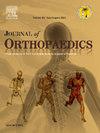Impact of tranexamic acid use in total hip replacement patients: A systematic review and meta-analysis
IF 1.5
Q3 ORTHOPEDICS
引用次数: 0
Abstract
Purpose
Tranexamic acid (TXA) dose in the context of primary complete hip replacements (THA) is still a hot debate about the best way to administer TXA. The need to select the most efficient and secure TXA dosing regimen, taking into account elements like perioperative bleeding, postoperative complications, and patient outcomes, has been emphasized by numerous studies. Improving clinical procedures and the general efficacy and safety of employing TXA in THA surgeries requires addressing this ongoing debate.
Methods
For this systematic review, We looked at the safety and efficacy of administering TXA intravenously (iTXA) and topically (tTXA) during THA. A thorough search turned up ten randomized controlled trials with 1295 individuals. Parameters evaluated included blood loss, Hb level on the day following surgery, transfusion rates, and drainage volume.
Results
Strategies had comparable impacts on deep vein thrombosis occurrences and wound complications. iTXA produced considerably less intraoperative blood loss (WMD = −12.687), concealed blood loss (WMD = 14.276), and the greatest hemoglobin drop (WMD = −0.400) when compared to tTXA.
Conclusion
Both administration techniques were secure and efficient in primary THA, although iTXA showed superior results in lowering blood loss and Hb decline.
全髋关节置换术患者使用氨甲环酸的影响:系统回顾和荟萃分析
目的 在初级全髋关节置换术(THA)中,氨甲环酸(TXA)的剂量仍是关于TXA最佳给药方法的热门话题。许多研究都强调,需要在考虑围手术期出血、术后并发症和患者预后等因素的基础上,选择最有效、最安全的氨甲环酸给药方案。要改进 THA 手术中使用 TXA 的临床程序以及总体疗效和安全性,就必须解决这一持续存在的争论。方法在这篇系统性综述中,我们研究了 THA 期间静脉注射 TXA(iTXA)和局部注射 TXA(tTXA)的安全性和疗效。通过全面搜索,我们发现了十项随机对照试验,共涉及 1295 人。评估参数包括失血量、术后第二天的血红蛋白水平、输血率和引流量。结论两种给药技术在初级 THA 中都安全有效,但 iTXA 在降低失血量和血红蛋白下降方面表现更优。
本文章由计算机程序翻译,如有差异,请以英文原文为准。
求助全文
约1分钟内获得全文
求助全文
来源期刊

Journal of orthopaedics
ORTHOPEDICS-
CiteScore
3.50
自引率
6.70%
发文量
202
审稿时长
56 days
期刊介绍:
Journal of Orthopaedics aims to be a leading journal in orthopaedics and contribute towards the improvement of quality of orthopedic health care. The journal publishes original research work and review articles related to different aspects of orthopaedics including Arthroplasty, Arthroscopy, Sports Medicine, Trauma, Spine and Spinal deformities, Pediatric orthopaedics, limb reconstruction procedures, hand surgery, and orthopaedic oncology. It also publishes articles on continuing education, health-related information, case reports and letters to the editor. It is requested to note that the journal has an international readership and all submissions should be aimed at specifying something about the setting in which the work was conducted. Authors must also provide any specific reasons for the research and also provide an elaborate description of the results.
 求助内容:
求助内容: 应助结果提醒方式:
应助结果提醒方式:


